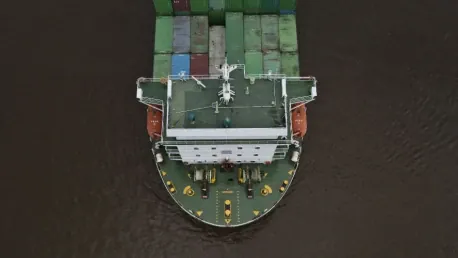The Global Maritime Forum (GMF) has released the fifth edition of its Mapping of Zero-Emission Pilots and Demonstration Projects report, which documents a significant rise in zero-emission initiatives. This latest edition highlights 340 projects, an increase from the 236 projects mentioned in the previous report. It paints a picture of an evolving maritime industry striving towards decarbonization through innovative technologies and solutions. Key areas of focus include ship technology, bunkering and infrastructure, and fuel production. This article delves into these areas, shedding light on the current trends and challenges within the maritime sector’s journey towards a zero-emission future.
Ship Technology Advancements
Dominance of Ammonia and Hydrogen Technologies
The report notes a pivotal moment in maritime decarbonization, with an evident shift from early-stage projects to commercial implementation. Dominating the ship technology landscape are ammonia and hydrogen combustion engines and fuel cells. These technologies represent a significant leap forward, as they transition from concept to practical applications. The focus on ammonia and hydrogen underlines the industry’s commitment to finding sustainable alternatives to traditional fossil fuels.
Interestingly, methanol-powered vessels, which were a primary focus in earlier reports, have now matured beyond the pilot phase. Their exclusion from this year’s analysis signifies their progression towards broader commercial adoption. The maturation of methanol-powered vessels paves the way for newer technologies to be explored and developed. This shift marks a critical evolution in maritime technology, reflecting the industry’s dynamic efforts to identify and implement viable zero-emission solutions.
Integration of Emerging Technologies
As the zero-emission projects progress, an emerging trend is the integration of various technologies to optimize performance and efficiency. Innovations such as fuel cells paired with battery systems and hybrid propulsion mechanisms are gaining traction. By combining different technologies, shipbuilders and operators can achieve better energy efficiency and reduce reliance on any single fuel source. This holistic approach not only improves operational efficiency but also contributes to reducing the maritime industry’s overall carbon footprint.
The convergence of technologies highlights the necessity for interdisciplinary collaboration within the maritime sector. Engineers, scientists, and industry experts are working together to overcome technical challenges, ensuring that these pioneering technologies can be seamlessly integrated into existing maritime operations. The collaborative nature of these efforts is crucial in driving the industry towards a sustainable future, where zero-emission vessels become the norm rather than the exception.
Bunkering and Infrastructure Needs
Onshore Projects Taking Precedence
A notable trend in this year’s report is the emphasis on onshore projects over offshore endeavors in the realm of bunkering and infrastructure. The focus is on establishing reliable and robust onshore systems, particularly for hydrogen and ammonia. These systems are essential for the seamless refueling of ships, ensuring that the adoption of zero-emission technologies is both practical and efficient. The development of onshore infrastructure is critical in supporting the maritime industry’s transition to alternative fuels and reducing its environmental impact.
The integration of fuel production with bunkering infrastructure is also gaining prominence. This approach streamlines the supply chain, reducing logistical challenges and ensuring a steady supply of alternative fuels to ports and vessels. By co-locating fuel production and bunkering facilities, the industry can achieve greater efficiency and sustainability. This synergy is crucial for advancing maritime decarbonization and achieving the sector’s long-term environmental goals.
Obstacles and Solutions
Despite the progress, fuel production projects face considerable challenges, including obtaining environmental approvals, securing significant investments, and addressing market demand uncertainties. These hurdles necessitate robust market signals and substantial financial and political backing. Stakeholders must work collaboratively to provide the necessary support and resources to advance these projects from concept to reality. The maritime industry’s commitment to overcoming these challenges is evident in the increasing number of public-private partnerships and international collaborations.
The future of maritime decarbonization depends heavily on the industry’s ability to navigate these obstacles and implement effective solutions. Increased transparency and information sharing about project results and progress could accelerate learning and consolidation around key technologies. By fostering open communication and collaboration, the industry can build a collective knowledge base that drives innovation and outlines best practices for implementing zero-emission solutions.
Geographic and Collaborative Insights
European Dominance and Developing Country Involvement
The report highlights a significant geographical disparity in project funding and participation, with European initiatives predominantly leading the charge. Increased involvement from companies and countries across Europe underscores the region’s commitment to maritime decarbonization. However, there is a notable absence of participation from developing countries, including small island states and least developed countries. Bridging this gap is essential for achieving global decarbonization goals and ensuring that all regions benefit from sustainable maritime practices.
The participation of developing countries is crucial for the global adoption of zero-emission technologies. Efforts to involve these regions in pilot projects and demonstrations could provide valuable insights and foster more inclusive progress. Additionally, extending funding opportunities to these areas would help balance the geographical disparities and support a more equitable distribution of resources and benefits. International cooperation and support are key to achieving a truly global transition to sustainable maritime operations.
Decrease in Publicly Funded Projects
The Global Maritime Forum (GMF) has unveiled the fifth edition of its Mapping of Zero-Emission Pilots and Demonstration Projects report. This new report reveals a notable increase in zero-emission projects, now showcasing 340 initiatives compared to the 236 highlighted in the previous edition. This rise underscores the maritime industry’s commitment to decarbonization using groundbreaking technologies and approaches. The report emphasizes three primary areas: ship technology, bunkering and infrastructure, and fuel production. Each of these areas plays a crucial role in the industry’s ongoing efforts to achieve a zero-emission future. The report further explores current trends and challenges the maritime sector faces on its path to eliminating emissions. Through focused development in these key areas, the industry demonstrates a strong dedication to reducing its carbon footprint and innovating for a sustainable future. This comprehensive examination of the maritime industry’s progression offers valuable insights into the future of zero-emission maritime activities.









